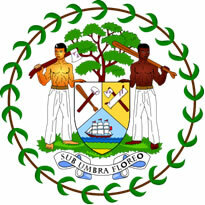Located in Central America, the territory of Belize occupies a narrow area of the Yucatan Peninsula in the Caribbean Sea, between Guatemala and Mexico. It borders Mexico, Honduras and Guatemala. Until 1973, the country was called British Honduras. Its independence was won in 1981.
Creoles, descendants of Africans, and indigenous and European mestizos make up the majority of the population, which is also made up of Indians, Mayans, Garifunas, Asians and Europeans of various origins.
Agriculture is the main economic activity developed in the country, with emphasis on the cultivation of citrus, sugarcane and bananas. Sugar is the main export product, and the banana products industry is the country's main employer. Tourism is another economic activity of great importance to Belize.
Migration flows to the United States are very common, currently (2010), there are more Belizeans residing in that country than in Belize.
Do not stop now... There's more after the advertising ;)

Belize Coat of Arms
Belize data:
Territorial extension: 22,965 km².
Location: Central America.
Capital: Belmopan.
Climate: tropical rainy.
Government: parliamentary monarchy.
Administrative division: 6 districts.
English language.
Religion: Christianity, 90.8% (Catholics, 56.7%, Protestants, 16.4%, no affiliation, 9%, others, 8.7%), Baha'ism, 2.9%, Hinduism, 2.3%, others, 3.2%, without religion and atheism, 0.8%.
Population: 306,777 inhabitants. (men: 154,619; women: 152,158).
Ethnic composition: African Americans, 44%, Creoles, 30%, Mayans, 11%, Garifunas, 7%, Europeans, 4%, Indians, 3.5%, others, 0.5%.
Demographic density: 12 inhabitants/km².
Average annual population growth rate: 2.38%.
Population residing in urban areas: 52.2%.
Population residing in rural areas: 47.8%.
Life expectancy at birth: 76 years.
Human Development Index (HDI): 0.694 (high).
Currency: Belize Dollar.
Gross Domestic Product (GDP): US$1,274 million.
GDP per capita: 4,429 US$.
External relations: World Bank, Caricom, Commonwealth, IMF, OAS, WTO, UN.
By Wagner de Cerqueira and Francisco
Graduated in Geography
Brazil School Team
countries - geography - Brazil School



